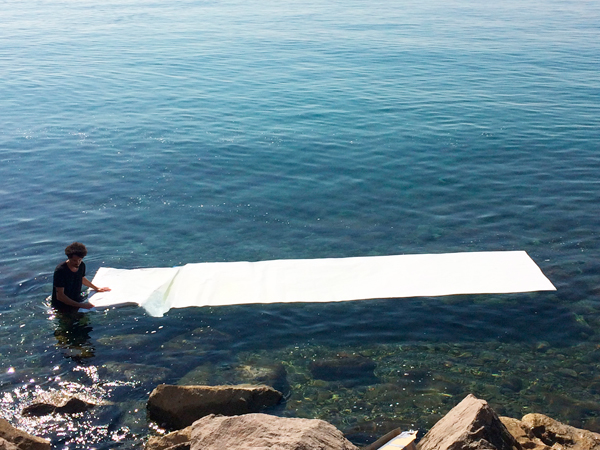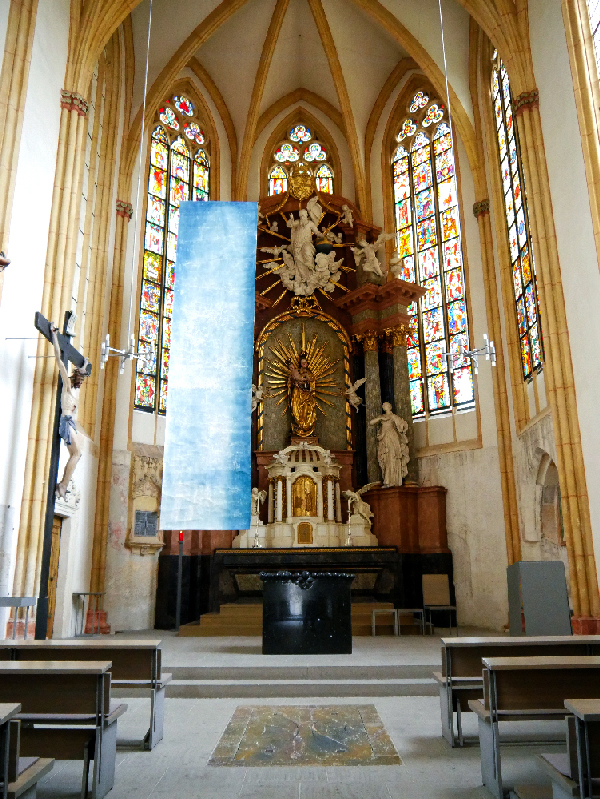Taking the Shadow of an Obelisk and letting it dissolve into the Sea
Cyanotype on paper,
metal structures
750 x 150 cm
Video
12′ 35″
2018
EN
Taking the Shadow of an Obelisk and letting it dissolve into the Sea consists of a large format cyanotype on paper and in a video showing the process of realization. The work is the result of the exposure to the sunlight of the photosensitive surface of the paper, placed beneath the shadow of the obelisk of Villa Opicina (Trieste) the moment when the sun was at the highest point.
Taking the Shadow of an Obelisk and letting it dissolve into the Sea consists of a large format cyanotype on paper and in a video showing the process of realization. The work is the result of the exposure to the sunlight of the photosensitive surface of the paper, placed beneath the shadow of the obelisk of Villa Opicina (Trieste) the moment when the sun was at the highest point.
The video shows in real time the process of chemical impression of the shadow on the paper and the following process of washing and development of the cyanotype in the Adriatic Sea, on the coast of Trieste.
In ancient Egypt the obelisk was conceived as a petrified sun ray, a symbol of the deity Ra, God of Sun.
The obelisk of Villa Opicina was erected on a promontory near Trieste in 1839, during the Austro-Hungarian Empire on the occasion of the inauguration of Strada Nuova per Opicina (the new street for Opicina) that connected the city of Trieste with Austria. The Obelisk of Opicina was dedicated to the Austrian Emperor Franz I von Habsburg-Lothringen.
IT
Taking
the Shadow of an Obelisk and letting it dissolve into the Sea
consiste in una cianotipia di grande formato su carta e in un video
che ne documenta il processo di realizzazione.
L’opera
é il risultato dell’esposizione al sole della superficie
fotosensibile della carta, posizionata nel cono d'ombra dell’obelisco
di Villa Opicina (Trieste) durante il picco di altezza massima del
sole.
Il
video, mostra in tempo reale il processo di impressione dell’ombra
sulla carta ed il successivo lavaggio e fissaggio della cianotipia
nel mare Adriatico, realizzato lo stesso giorno sulla costa
triestina.
Per
gli antichi egizi l’obelisco era un raggio di sole pietrificato e
simboleggiava il Dio del Sole Ra.
L’obelisco
di Villa Opicina fu eretto sul ciglio di un promontorio vicino a
Trieste nel 1839 durante l’impero Austro-Ungarico in onore
dell’Imperatore d’Austria Francesco II d'Asburgo-Lorena, in occasione
dell’apertura della Strada Nuova per Opicina che collegava Trieste
all’Austria.
Ryts Monet, Taking the Shadow of an Obelisk and letting it dissolve into the Sea, video, 12′ 35″, 2018.

Ryts Monet, Taking the Shadow of an Obelisk and letting it dissolve into the Sea,
still from video, 2018.



Ryts Monet, Taking the Shadow of an Obelisk and letting it dissolve into the Sea,
installation view at Galleria Michela Rizzo, Venezia, 2019.

Ryts Monet, Taking the Shadow of an Obelisk and letting it dissolve into the Sea,
installation views at Per Tina, Steirischer Herbst Parallel Program,
Leechkirche, Graz, Austria, 2020.

Quotidiana - Paesaggio, Alterazioni Video / Ryts Monet, curated by Marie-Therese Bruglacher,
exhibition view at Museo di Roma, Palazzo Braschi, photo credits by Carlo Romano, video by Anton Giulio Onofri,
Fondazione La Quadriennale di Roma, 2023.